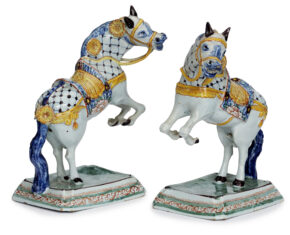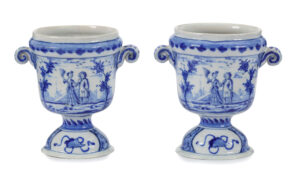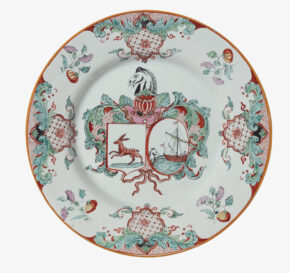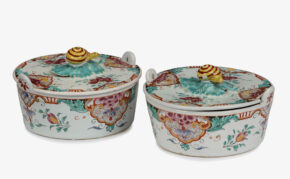![]()
Images on this website are licensed under a
Creative Commons Attribution-NoDerivs 3.0 Unported License.
OBJECT
D2445. Pair of Polychrome Recumbent Goats
Delft, circa 1765
A pair of very fine recumbent goats, each with manganese and blue painted striated hide, and modeled affronté, lying on the yellow-green grass surface, surrounded by a polychrome leaf band on the rim of a conformingly- shaped low mound base.
DIMENSIONS
Height: 8.5 cm. (3.4 in.)
Width: 10 cm. (3.9 in.)
NOTE
The pair of recumbent goats are unmarked and therefore, not attributable to a specific Delft factory, however the streaky manganese decoration and the manganese-edged grassy base places them in a group with a pair of Delft figures of horses, also unmarked, but with the same decorative characteristics, illustrated in Aronson 2015, pp. 134-135, no. 79. The present goats also relate to a group of recumbent cows, illustrated in Aronson 2019, pp. 116-117. The streaky decoration also appears on the goats’ coats on a pair of covered butter tubs modeled as boys on billygoats marked for ‘De Drie Posteleyne Astonne’ (The Three Porcelain Ash-Barrels) factory, circa 1760-70, illustrated in Aronson 2004, p. 153, no. 175; and in the Catalogue of the European Fine Art Fair (TEFAF), Maastricht, 2003, p. 160. However, these goats are of different model from the present pair.
SIMILAR EXAMPLES
Recumbent goats, displaying a similar decoration and unmistakably originating from the same moulds, were crafted by the De Twee Scheepjes (Two Little Ships) factory. These pieces bear the mark “AP” for Anthonij Pennis, owner of the Twee Scheepjes factory from 1764 to 1770, and later by his widow, Pennis- Overgaauw, from 1770 to 1782. Notably, these goats are featured in Aronson Delftware Collections, Volume II, 2021, on pages 64-65. Additionally, a pair butter tubs with similar goats affixed to the lids, marked for ‘De Drie Astonne’ (the Three Porcelain Ash-Barrels), are housed in the collection of the Kunstmuseum The Hague, with inventory number 400892. Molds were exchanged between factories if owners changed, or inventories were sold. Another possibility might be an employee who takes a mould to a new employer, but no evidence has been found in this case.









